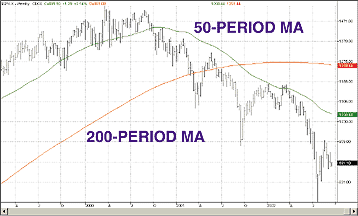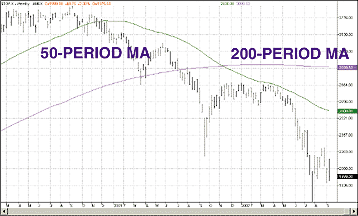INTERMARKET REVIEW
US Dollar Index
The US dollar index is based on a trade-weighted geometric average of six foreign currencies against the US dollar. These currencies are the euro, the yen, the British pound, the Canadian dollar, the Swedish krona, and the Swiss franc.
The mighty greenback finally gave ground in spring 2002, more than two years after the peak of the US equities markets. After riding its 50-day moving average up toward highs not seen since the strong dollar days of the mid-1980s, the US dollar index crashed through the 50-day moving average in April and fell through its 200-day moving average in June.

What they say: "The dollar is still transitioning from its 1997-2001 strengthening trend to a stable trend that will be constructive for the economy and, eventually, for equity markets. A stable dollar trend would imply low inflation and less interest rate volatility going forward. But to be fully confident in this view, we need Washington to clarify its dollar policy." - David Malpass, chief international economist for Bear Stearns. From "These Dollar Drops Are Okay...," National Review online, www.nationalreview.com, June 2002
Standard & Poor's 500 Index
The Standard & Poor's 500 is an index of 500 widely traded stocks selected for market size, liquidity, and industry group representation. The S&P 500 is market capitalization-weighted and is among the most widely used benchmarks for US stock performance.
The first few years of the 21st century have been difficult for US equities, as this chart of the S&P 500 shows. After falling beneath its 50-day moving average for good in summer 2000, the S&P 500 continued its descent for another two years, falling beneath its 200-day moving average in the summer of 2001.

What they say: "Bubbles are often precipitated by perceptions of real improvements in the productivity and underlying profitability of the corporate economy. But as history attests, investors then too often exaggerate the extent of the improvement in economic fundamentals. Human psychology being what it is, bubbles tend to feed on themselves, and booms in their later states are often supported by implausible projections of potential demand." Alan Greenspan, Federal Reserve Board chairman, August 2002: speech at a symposium in Jackson Hole, WY
Nikkei 225
The Nikkei 225 stock average is the most widely followed stock market index in Japan. The Nikkei 225 represents 225 of the most actively traded stocks on the Tokyo Stock Exchange.
The relentlessly bearish equities markets in Japan were in full effect in 2000 and 2001, as the Nikkei 225 traded beneath both its 50- and 200-day moving averages after an initial collapse early in 2000. The first half of 2002 showed some leveling off of the two long-term moving averages, as Nikkei investors hoped that the declines from the fall of 2002 might mark a test of the previous year's summer lows.

What they say: "Japan's borrow-and-pave ways haven't ended its 11-year slump, and have only shackled it with the largest public debt among developed economies. That's prompted ratings agencies to downgrade Japan's credit, leaving it a notch lower than Botswana. It's also led to corruption among politicians who dole out the projects and companies that get them." William Pesek Jr., columnist. From "Good News For Japan's Economy-Finally," Bloomberg.com, September 2002
10-year Treasury Note
The 10-year Treasury note is a debt obligation issued by the US government. Increasingly, the 10-year Treasury note is being viewed as the benchmark, long-term Treasury security by debt market participants, essentially replacing the 30-year bond. Bond prices move inversely to bond yields, so higher bond prices mean lower bond yields.
The bull market in the 10-year Treasury has probably been the most significant bull market since 2000. Trading above its 200-day moving average in late 2000, the 10-year Treasury advanced strongly until autumn 2001, when prices briefly slipped beneath their 50-day moving average. Although the 10-year Treasury again struggled in early 2002, by summer the 10-year Treasury by all accounts had regained its bullish ways.

What they say: "In other words, even at today's exceedingly low levels of nominal interest rates, it does not appear that an outright deflationary scare is currently in the price of long-dated Treasuries. There's an important corollary to that observation: Shocking as it may seem, I believe long rates could actually fall a good deal further from today's rock-bottom levels if fears of outright deflation were to intensify." Stephen Roach, chief economist and director of global economic analysis for Morgan Stanley. From "A Deflationary Mosaic," www.morganstanley.com, August 2002
The CRB Index
The Commodities Research Bureau (CRB) futures index consists of 17 different futures markets: cattle, cocoa, coffee, copper, corn, cotton, crude oil, gold, heating oil, hogs, natural gas, orange juice, platinum, silver, soybeans, sugar, and wheat. The CRB index is an unweighted geometric mean or a simple ratio of the current prices to the base year average price (that is, 1967=100).
Volatility among the commodities has been the order of the first few years of the 21st century. The whipsawing of the CRB index over the past three years - the bull market in commodities from mid-1999 to late 2000, the bear market from late 2000 to late 2001, and the bull market that began with a successful test of bottom in early 2002 - has provided for significant opportunities in the futures commodity markets. Yet on the whole, the CRB index has remained between the 220 and 180 range that has characterized relative commodity price stability since 1971.

What they say: "... and if I am right in assuming that the US empire is already past its peak, then we will have to cope in years to come with higher and higher inflation and interest rates, and a weakening dollar. My advice is, therefore, to avoid for now US financial assets and to invest in commodities such as gold and the grains ..." Marc Faber, investment advisor, The GloomBoomDoom Report. From "The Curse Of Empires," www.gloomboomdoom.com, May 2002
FTSE Eurotop 100 Index
The FTSE Eurotop 100 Index consists of 100 of the most widely traded
European stocks. The FTSE Eurotop 100 index is also a tradable commodity
in and of itself, with both futures and options on the European index traded
daily.
Particular weakness in European stocks was observable by the FTSE
Eurotop 100's fall beneath its 50-day moving average in late 2000. It subsequently
crashed through its 200-day moving average in summer 2001. In most respects,
the FTSE Eurotop 100 appears to have followed the leadership of the US
equities market - for better and worse - over the past three years, with
nearly identical corrections and countertrend rallies from 2000 to the
present day.

What they say: "Another consequence of the lax public spending stance pursued for many years was entrenched large-budget deficits and ballooning government debt levels. The resulting detrimental effects are likewise widely recognized today: loss of macroeconomic efficiency, lower investment, loss of confidence on the financial markets, and increased risk of negative external effects." Jurgen Stark, vice president of Bundesbank. From "A Pact Worth Keeping," Financial Times op-ed, September 2002
Originally published in the November 2002 issue of Technical Analysis of STOCKS & COMMODITIES magazine. All rights reserved. © Copyright 2002, Technical Analysis, Inc.